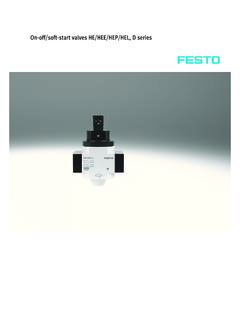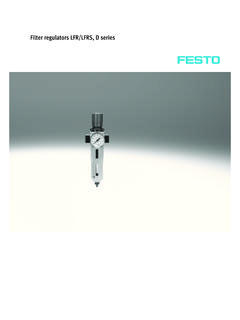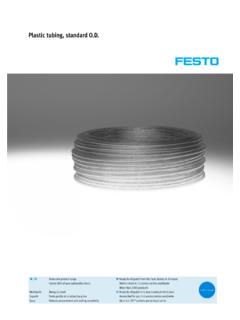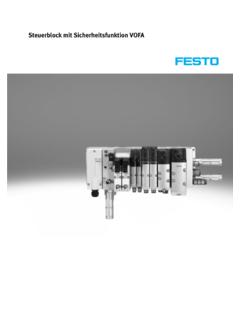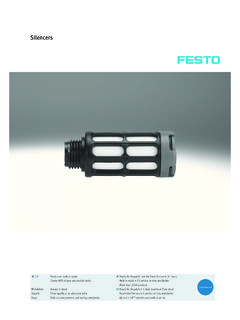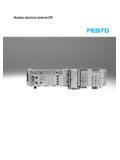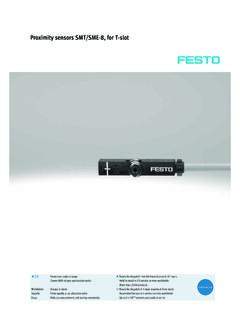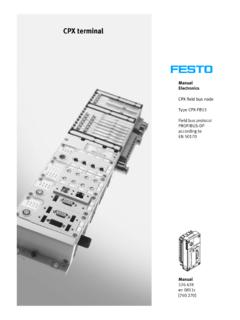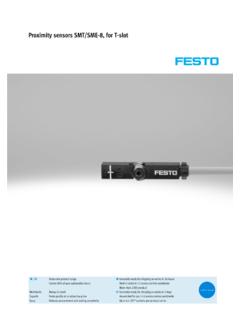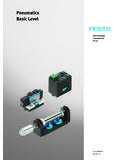Transcription of Conditions for operation, storage and transport of Festo ...
1 General operating Conditions Conditions for operation, storage and transport of Festo products What must be taken into account when using Festo products? The limit values specified in the technical data and any specific safety instructions You are unsure about the product's suitability for use in safety-oriented must be adhered to by the user in order to ensure correct functioning. applications. The pneumatic components must be supplied with correctly prepared compressed All technical data is correct at the time of going to print. air free of aggressive media a page 3 onwards. All content, texts, illustrations, images and drawings included in this catalogue Take into consideration the ambient Conditions at the location of use.
2 Corrosive, are the intellectual property of Festo SE & Co. KG and are protected by copyright abrasive and dusty environments ( water, ozone, grinding dust) will reduce the law. service life of the product. Check the resistance of the materials of Festo products to the media used and Any duplication, processing, translation, microfilming, storage , or processing in surrounding media a page 21. electronic systems of any kind whatsoever without the consent of When Festo products are used in safety-oriented applications, all national and Festo SE & Co. KG is prohibited. international laws and regulations, for example the Machinery Directive, together with the relevant references to standards, trade association rules and the All technical data is subject to change according to technical advances.
3 Applicable international regulations must be observed and complied with. Unauthorised conversions or modifications to products and systems from Festo constitute a safety risk and are thus not permitted. Festo does not accept any liability for any resulting damages. You should contact Festo if one of the following applies to your application: The ambient Conditions and operating Conditions or the operating medium differ from the specified technical data. The product is to perform a safety function. A risk or safety analysis is required. You are unsure about the product's suitability for the planned application.
4 storage Conditions Temperature When repairs are being made to the building technology systems in the ware- The temperature range in storage areas must be between 10 C and 40 C all year house (welding, grinding etc.), the stored goods should be protected from welding round. Rapid changes of temperature in the storage area should be avoided. Heat spatter, chips etc. sources such as heating elements, heating pipes and the like should be shielded to ensure the stored goods are not directly subject to radiant heat. Adding to/removing from storage The parts should not be exposed to any extreme fluctuations in temperature.
5 UV radiation No direct sunlight (skylights, vent flaps, etc.) and no high-UV artificial lighting. Mechanical effect Use fluorescent tubes with UV protection. All products, including packs of spare parts/wearing parts for example, should be stored in such a way that they are not mechanically deformed or damaged, no Ambient air buckling or sagging, no point loads. Direct contact between elastomer products Air circulation and permanently feeding (proportionally) ambient air to the storage and copper or manganese for an extended period should also be avoided room is absolutely essential. You must prevent any media that may affect the ma- because of possible reciprocal effects.
6 Terials, solvents and the like arising from production processes, from entering the storage areas. The storage location should not contain any equipment that Stock management generates ozone such as indoor air ionisers or high-voltage equipment. To avoid storing parts for long periods of time, the first-in first-out principle The relative humidity should not exceed 75%. Condensation must be avoided in should be followed. The total storage duration should be kept as short as all cases. possible. In principle, the specified guarantee periods apply. Dust The parts must be stored in suitable containers.
7 The storage room must as far as possible be free of dust. Attention should be paid in particular to using abrasion-resistant, non-porous floor coverings, and ingress of dust particles from external sources (ambient air) should be prevented. transport Conditions In principle, there are no restrictions in terms of ambient Conditions during land/ temperature-controlled transport can be organised. However, this should be sea or air transport , provided the products are sufficiently protected in accord- agreed contractually and as a separate financial matter. ance with the specifications in the product data sheet by using appropriate product and shipping packaging.
8 If necessary, special transport such as 2020/10 Subject to change d Internet: 1. General operating Conditions Standards in pneumatics Warning symbols to IEC 60417. Standards in pneumatics Standards are also of great importance in pneumatics. Standards mean harmoni- pneumatics deal with dimensions, safety and quality. Festo has for many years sation. Standardisation is also the basis for the free trade of goods and services been actively working with the relevant national and international standards between companies nationally as well as internationally. organisations. Standards in industry describe the latest state of technology.
9 They provide a common basis for the evaluation of technical aspects. Standards relevant for Pneumatic drives Standards-based cylinders to ISO 6432 Rod clevises to ISO 8140 and DIN 71752. Standards-based cylinders to ISO 21287. Rod eyes to ISO 12240-4, dimension series K. Standards-based cylinders to ISO 15552 (ISO 6431, DIN ISO 6431, VDMA 24562), NFE and UNI 10290. valves /valve terminals Valve terminals for standards-based valves . Valve sub-bases with port pattern to iso 5599 -1 and external dimensions to Solenoid and pneumatic valves with port pattern to ISO 15407-1. VDMA 24345. Valve sub-bases to ISO 15407-1.
10 Solenoid valves with port pattern to VDI/VDE 3845 (NAMUR). Valve terminals with port pattern to ISO 15407-2. Solenoid and pneumatic valves with port pattern to iso 5599 -1. Valve terminals with port pattern to DIN iso 5599 -2. Compressed air preparation Compressed air quality according to ISO 8573-1:2010. Bourdon tube pressure gauges to EN 837-1. Capsule pressure gauges to EN 837-3. Air reservoirs to directive 2014/68/EU, 2014/29/EU or EN 286-1. Warning symbols to IEC 60417. Warning symbols are displayed on certain products and packaging from Festo . These symbols identify products that require specialist expertise to install.
